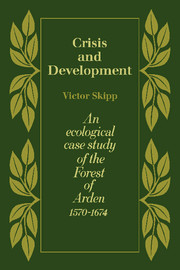Book contents
- Frontmatter
- Contents
- List of figures
- List of tables
- Acknowledgements
- PART ONE THE CONTEXT
- PART TWO THE CASE STUDY
- 4 The demographic crisis of 1613–19
- 5 Negative responses
- 6 The ecological problem
- 7 Positive responses: agrarian change
- 8 Positive responses: new employment openings
- 9 Model of demographic, economic and social developments, 1575–1649
- 10 The new ecological regime, 1625–74
- 11 The social cost
- PART THREE IMPLICATIONS
- Appendix 1 The practice of birth control
- Appendix II Estimates of population size
- Notes
- Index
9 - Model of demographic, economic and social developments, 1575–1649
Published online by Cambridge University Press: 05 November 2011
- Frontmatter
- Contents
- List of figures
- List of tables
- Acknowledgements
- PART ONE THE CONTEXT
- PART TWO THE CASE STUDY
- 4 The demographic crisis of 1613–19
- 5 Negative responses
- 6 The ecological problem
- 7 Positive responses: agrarian change
- 8 Positive responses: new employment openings
- 9 Model of demographic, economic and social developments, 1575–1649
- 10 The new ecological regime, 1625–74
- 11 The social cost
- PART THREE IMPLICATIONS
- Appendix 1 The practice of birth control
- Appendix II Estimates of population size
- Notes
- Index
Summary
In Figure 3 4 an attempt has been made to represent the demographic, economic and social developments under consideration in diagrammatic form. The rectangular frame is intended to signify the boundary of the five parishes. Boxes inside this frame are therefore concerned with internal developments, while those outside it represent exterior factors or inputs. A chronology has been indicated in the left-hand margin, with the key population estimates at an appropriate point on the right. As far as possible, boxes have been positioned and scaled in relation to the chronology; but, because of restrictions of layout, and also because many of the developments cannot be precisely dated, this visual chronology should be regarded as no more than approximate.
Boxes 1 and 2 represent what we have called the ecological equilibrium of the mid Tudor period: when a comparatively small population was gaining its livelihood – as had the previous five or six generations – by practising pasture farming, with the main emphasis on stock rearing and beef production. From the 1570s, however, this state of equilibrium is being undermined by a sharp population increase 5, which is due partly to internal demographic pressure 4, and partly to the fact that external demographic pressure is engendering an unprecedentedly high rate of immigration 3.
- Type
- Chapter
- Information
- Crisis and DevelopmentAn Ecological Case Study of the Forest of Arden 1570–1674, pp. 64 - 75Publisher: Cambridge University PressPrint publication year: 1978



